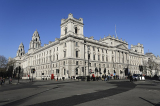
On Wednesday, May 8, 2024, the Thames Barrier celebrates its 40th anniversary since its inauguration by the late Queen in 1984. Erected as one of the largest movable barriers globally,
this engineering marvel continues to serve as a critical defense against flooding, ensuring the safety of London and the Thames Estuary.
Operated and maintained by the Environment Agency, the Thames Barrier, along with other flood defenses across the estuary, shields 125 square kilometers of central London, safeguarding over 1.42 million people and invaluable cultural heritage sites. With assets worth £321 billion protected, the barrier plays a pivotal role in averting potential devastation caused by storm surges and tidal flooding.
In its four decades of operation, the Thames Barrier has been closed 221 times for flood defense, underscoring its indispensable role in protecting London's infrastructure and inhabitants. Originally designed to operate until 2030, the barrier's robust construction ensures its continued efficacy until 2070.
Looking ahead, the Thames Estuary 2100 plan outlines strategies for managing flood risks in the region amidst the evolving challenges posed by climate change. The Environment Agency commits to collaborating with partners to devise long-term solutions, ensuring London's resilience against future threats.
The anniversary also marks the retirement of Andy Batchelor, the Thames Barrier's Manager, who has dedicated 25 years to its operation. His legacy embodies the barrier's enduring commitment to excellence and safety.
Reflecting on the milestone, Andy Batchelor expressed pride in the barrier's legacy and emphasized the ongoing efforts to address rising sea levels and ensure London's protection for generations to come. Caroline Douglass, Executive Director for Flood and Coastal Risk Management at the Environment Agency, echoed this sentiment, underscoring the agency's dedication to bolstering London's resilience through proactive flood risk management.
The Thames Barrier stands as a testament to human ingenuity and resilience in the face of adversity. Born out of the need to safeguard London following the devastating floods of 1953, its construction embodies the nation's commitment to protecting communities from natural disasters.
Constructed over eight years at a cost of £535 million, the barrier's design features ten steel gates capable of rising into position across the River Thames when necessary. During the severe storms of 2013/14, the barrier's effectiveness was demonstrated as it prevented flooding in London despite facing the highest tide since its inception.
As the UK grapples with the impacts of climate change, urgent action is needed to mitigate the risks posed by rising sea levels and extreme weather events. The Environment Agency remains steadfast in its mission to protect lives and properties, investing billions in flood defense infrastructure and technology.
The Thames Barrier stands as a symbol of resilience and innovation, embodying the nation's commitment to safeguarding its future against the uncertainties of a changing climate. Photo by Andy Roberts from East London, England, Wikimedia commons.



































